What'sNEW Archives, January-March 2005
 29 Mar 2005
29 Mar 2005
Micro-organisms could be transported [via meteorites] from a planet where life is ending to a planet where favourable conditions for its re-birth are encountered — Bruno Lopez, Jean Schneider and William Danchi
 Bruno Lopez et al., "Can Life develop in the expanded habitable zones around Red Giant Stars?" [abstract], e-Print Archive: astro-ph/0503520, Mar 2005. Bruno Lopez et al., "Can Life develop in the expanded habitable zones around Red Giant Stars?" [abstract], e-Print Archive: astro-ph/0503520, Mar 2005.
 Dying stars could make frozen planets habitable, by Maggie McKee, NewScientist.com, 29 Mar 2005. Dying stars could make frozen planets habitable, by Maggie McKee, NewScientist.com, 29 Mar 2005.
 Introduction... and Introduction... and  How Is It Possible? are related CA webpages. How Is It Possible? are related CA webpages.
 Thanks, Larry Klaes. Thanks, Larry Klaes.

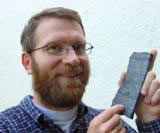
Aivo Lepland |
24 Mar 2005
Evidence for very old life is questioned. In 1996, geochemists Stephen J. Mojzsis et al. concluded that isotope ratios in graphite grains from Greenland were indicative of life 3.85 billion years ago. Controversy ensued. Now, Aivo Lepland's international team can't even find the critical graphite grains. (Gustaf Arrhenius was a member of both teams.) We suspect that the issue will not end here. More importantly, we wonder why Nature's commentary begins, "How, where and when did life start?" If the 1996 analysis was correct, cellular life was probably present early in Earth's history. If Lepland et al. are right, perhaps life was not already present here by then. Either way, we learn nothing about how life started, or even if life started. Maybe life on Earth arrived.
 Aivo Lepland et al., "Questioning the evidence for Earth's earliest life–Akilia revisited" [abstract], p 77-79 v 33 n 1 Geology, 10 Mar 2005. Aivo Lepland et al., "Questioning the evidence for Earth's earliest life–Akilia revisited" [abstract], p 77-79 v 33 n 1 Geology, 10 Mar 2005.
 Stephen Moorbath, "Dating earliest life" [text], p 155 v 434 Nature, 10 Mar 2005. Stephen Moorbath, "Dating earliest life" [text], p 155 v 434 Nature, 10 Mar 2005.
 Life Before 3850 Million Years Ago? is a related CA webpage about Mojzsis et al., 7 Nov 1996. Life Before 3850 Million Years Ago? is a related CA webpage about Mojzsis et al., 7 Nov 1996.
 The Beginning, another CA webpage, argues that life did not have to "start". The Beginning, another CA webpage, argues that life did not have to "start".


mutant and revertant Arabidopsis thaliana |
24 Mar 2005
Plants can overwrite unhealthy genes, according to botanists studying the mustard plant, Arabidopsis thaliana, at Purdue University. They write, "plants homozygous for recessive mutant alleles of the organ fusion gene HOTHEAD (HTH) can inherit allele-specific DNA sequence information that was not present in the chromosomal genome of their parents but was present in previous generations." Other geneticists are saying that the finding is a huge surprise.
The phenomenon is reminiscent of "gene conversion," whereby a mutant allele can be corrected to match the uncorrupted allele, if it is present. But here, apparently, no uncorrupted copy is present. Has an RNA transcript of the normal gene somehow been inherited from the grandparents' generation? Understatedly the botanists note, "It will be of great interest to see how widely this mechanism of inheritance is distributed throughout the tree of life."
In our theory, evolutionary advances depend on the installation of genetic programs delivered by gene transfer. That process would require near-perfect fidelity in the replication stage. (Mutability would allow adaptation within narrow ranges.) To achieve such fidelity, eukaryotic genomes must employ high-level genetic software maintenance systems, such as known DNA-repair systems. The process observed here would exemplify an especially impressive capability of this software maintenance.
 Susan J. Lolle et al., "Genome-wide non-mendelian inheritance of extra-genomic information in Arabidopsis" [abstract], p 505-509 v 434, Nature, doi:10.1038/nature03380, 24 Mar 2005. Susan J. Lolle et al., "Genome-wide non-mendelian inheritance of extra-genomic information in Arabidopsis" [abstract], p 505-509 v 434, Nature, doi:10.1038/nature03380, 24 Mar 2005.
 Detlef Weigel and Gerd Jürgens, "Hotheaded healer" [text], p 443 v 434, Nature, 24 Mar 2005. Detlef Weigel and Gerd Jürgens, "Hotheaded healer" [text], p 443 v 434, Nature, 24 Mar 2005.
 Elizabeth Pennisi, "Talking About a Revolution: Hidden RNA May Fix Mutant Genes" [abstract], p 1852-1853 v 307, Science, 25 Mar 2005. Elizabeth Pennisi, "Talking About a Revolution: Hidden RNA May Fix Mutant Genes" [abstract], p 1852-1853 v 307, Science, 25 Mar 2005.
 Christopher Surridge, "Taking after Grandma" [text], p 251 v 6, Nature Reviews Genetics, Apr 2005. Christopher Surridge, "Taking after Grandma" [text], p 251 v 6, Nature Reviews Genetics, Apr 2005.
 Cress overturns textbook genetics, by Helen Pearson, News@Nature.com, 23 Mar 2005. Cress overturns textbook genetics, by Helen Pearson, News@Nature.com, 23 Mar 2005.
 Rogue weeds defy rules of genetics, by Andy Coghlan, NewScientist.com, 23 Mar 2005. Rogue weeds defy rules of genetics, by Andy Coghlan, NewScientist.com, 23 Mar 2005.
 Neo-Darwinsm... is a related CA webpage. Neo-Darwinsm... is a related CA webpage.
 Why Sexual Reproduction? has a section about gene conversion. Why Sexual Reproduction? has a section about gene conversion.
 Viruses... is a related CA webpage listing many examples of gene transfer. [Next-What'sNEW about HGT-Prev] Viruses... is a related CA webpage listing many examples of gene transfer. [Next-What'sNEW about HGT-Prev]
 3 Oct 2006: Can plants overwrite unhealthy genes? 3 Oct 2006: Can plants overwrite unhealthy genes? 
 18 Mar 2005
18 Mar 2005
Fresh-looking snow on Mars is visible in new photos from The European Space Agency's High Resolution Stereo Camera. In this scene from the Martian north pole region, the snow in the foreground has receded in the second image and the exposed terrain looks wet. (For scale, the cliff approaches two kilometers in height.) Viewing ESA's high resolution images, we wonder: is there a muddy frozen lake below the cliff?
 Glacial, volcanic and fluvial activity on Mars: latest images, European Space Agency, 25 Feb 2005. Glacial, volcanic and fluvial activity on Mars: latest images, European Space Agency, 25 Feb 2005.
 Steep Cliffs on Mars, Astronomy Picture of the Day, 15 Mar 2005. Steep Cliffs on Mars, Astronomy Picture of the Day, 15 Mar 2005.
 Life on Mars! is a related CA webpage. Life on Mars! is a related CA webpage.
 Thanks, Richard Hoover. Thanks, Richard Hoover.

 16 Mar 2005
16 Mar 2005
Cambridge Professor Simon Conway Morris may be the world's foremost authority on the evolutionary phenomenon known as convergence. His book Life's Solution: Inevitable Humans in a Lonely Universe lists over 400 examples and describes many of them in detail. Curious about evolutionary convergences for our own reasons, we read the book with keen interest.
We were delighted to agree with many of Conway Morris's nonstandard opinions, such as his scepticism about the current origin-of-life scenarios (chapter 4), and his estimate that the landscape of amino acid or nucleotide sequences is mostly barren (p 127, 308-309).
| convergent evolution: The development of superficially similar structures in unrelated organisms.... – A Concise Dictionary of Biology, Oxford University Press | |
In Life's Solution, Conway Morris doesn't attempt to fully explain convergence; he only claims that studying it will lead evolutionary science out of its blind and hopeless current state. Of course, we agree that studying convergence should be fruitful, but we are not entirely comfortable with Conway Morris's approach. First, in spite of his stated aversion to teleology, his language seems teleological to us. Witness the metaphor of "navigation," the chaos-theory image of "'attractors' by which evolutionary trajectories are channeled," and the terms "propensity" and "inherency". (But inherency would also apply to our evolutionary philosophy!)
Our main complaint is that Conway Morris pays too little attention to another possible account for apparent convergences, namely horizontal gene transfer. "There are certainly now a number of well-attested examples of transfers, but for the most part they seem to entail exchange between more primitive organisms," he writes (p 327). Actually, gene transfer dominates prokaryotic evolution and is very common at all levels of life. Furthermore, if the difference in "structural genes" between humans and chimps is less that 0.4% (p 5), and only about 300 genes distinguish humans from mice, maybe rare transfers are sufficient, at this stage!
Conway Morris states, "Identifying examples of... convergence, presupposes, of course, a reliable phylogeny" (p 286). But all species have genes with incongruent phylogenies, and genes can be transferred among even distantly related groups. Better evidence for his convergences would be two or more clearly unrelated genetic programs for the same feature.
Among the many examples of convergence, only a few, like rhodopsins (p 171-172), Pax-6 (p 241), and haemoglobin (p 287-288) are accompanied by genetic discussion. In those cases, the sequence similarities are noteworthy to us. In at least one case Conway Morris admits that conservation is a more plausible explanation than convergence (p 242). But with respect to photosynthesis, he has no doubts. "The C4 photosynthetic pathway is biochemically very complex, so complex in fact that it might be thought to have evolved in only one group of plants which fortuitously stumbled upon this solution. Not a bit of it: C4 photosynthesis is rampantly convergent and is believed to have arisen independently at least 31 times" (p 293). How is he so sure that the essence of this program wasn't distributed by gene transfer, as with bacterial photosynthesis?
To risk being over-critical, we didn't like his reservations about "naturalism" (p 48, 310), nor his equating adaptation with invention. But there is so much more that we do like. We mainly wish that Conway Morris would thoroughly scrutinize, not the morphological, but the molecular evidence behind convergence. Then he might see many examples of conserved genetic programs, for which gene transfer is an excellent explanation.
 Simon Conway Morris, Life's Solution: Inevitable Humans in a Lonely Universe, Cambridge Unversity Press, 2003. Simon Conway Morris, Life's Solution: Inevitable Humans in a Lonely Universe, Cambridge Unversity Press, 2003.
 PDF: Contingency or Inevitability?..., a review by Elliott Sober published in The New York Times, 30 Nov 2003. PDF: Contingency or Inevitability?..., a review by Elliott Sober published in The New York Times, 30 Nov 2003.
 Neo-Darwinsm..., a related CA webpage, has a section on Convergent Evolution. Neo-Darwinsm..., a related CA webpage, has a section on Convergent Evolution.
 Viruses... is a related CA webpage listing many examples of gene transfer. [Next-What'sNEW about HGT-Prev] Viruses... is a related CA webpage listing many examples of gene transfer. [Next-What'sNEW about HGT-Prev]
 Todd A. Castoe et al., "Evidence for an ancient adaptive episode of convergent molecular evolution" [abstract], doi:10.1073/pnas.0900233106, Proc. Natl. Acad. Sci. USA, online 2 Jun 2009. Todd A. Castoe et al., "Evidence for an ancient adaptive episode of convergent molecular evolution" [abstract], doi:10.1073/pnas.0900233106, Proc. Natl. Acad. Sci. USA, online 2 Jun 2009.

 15 Mar 2005
15 Mar 2005
Astrobiology IX, a conference sponsored by The International Society for Optical Engineering (SPIE), will be held as part of the society's annual meting in San Diego CA, 31 July - 4 August 2005. The Conference Chairs are Richard B. Hoover, NASA National Space Science and Technology Center; Gilbert V. Levin, Spherix, Inc.; and Alexei Y. Rozanov, Paleontological Institute (Russia).
 Instruments, Methods, and Missions for Astrobiology IX (OEI139) — conference homepage. Instruments, Methods, and Missions for Astrobiology IX (OEI139) — conference homepage.
 24 Feb 2005: Richard Hoover revives bacteria frozen for 30,000 years. 24 Feb 2005: Richard Hoover revives bacteria frozen for 30,000 years.

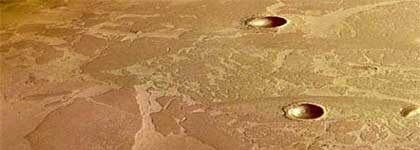 | photo width = c. 25 km |
15 Mar 2005
A frozen ocean on Mars today? Studying photos of the landscape in Mars' southern Elysium, ESA scientists say, "We have found evidence consistent with a presently-existing frozen body of water, with surface pack ice... similar in size and depth to the North Sea." Using crater counts, they estimate that its surface froze around 5 million years ago. A protective layer of volcanic ash could prevent sublimation of the ice, but lava flows could not have moved the broken surface plates. These are more likely the remnants of ice floes, they say. They believe the ocean still exists because the surface is too flat, and the submerged craters are too shallow to explain otherwise.
 John B. Murray et al., "Evidence from HSRC Mars Express for a Frozen Sea Close to Mars' Equator" [PDF abstract], Lunar and Planetary Science XXXVI, Houston TX, 14-18 Mar 2005. John B. Murray et al., "Evidence from HSRC Mars Express for a Frozen Sea Close to Mars' Equator" [PDF abstract], Lunar and Planetary Science XXXVI, Houston TX, 14-18 Mar 2005.
 John B. Murray et al., "Evidence from the Mars Express High Resolution Stereo Camera for a frozen sea close to Mars' equator" [abstract], p 352-356 v 434, Nature, doi:10.1038/nature03379, 17 Mar 2005. John B. Murray et al., "Evidence from the Mars Express High Resolution Stereo Camera for a frozen sea close to Mars' equator" [abstract], p 352-356 v 434, Nature, doi:10.1038/nature03379, 17 Mar 2005.
 The Martian Frozen Sea, John Murray interviewed by Leslie Mullen, Astrobiology Magazine, 14 Mar 2005. The Martian Frozen Sea, John Murray interviewed by Leslie Mullen, Astrobiology Magazine, 14 Mar 2005.
 Life on Mars! is a related CA webpage. Life on Mars! is a related CA webpage.

 15 Mar 2005
15 Mar 2005
Biology today is no more fully understood in principle than physics was a century or so ago.
 Carl R. Woese, "A New Biology for a New Century" [abstract], p 173-186 v 68, Microbiology and Molecular Biology Reviews, June 2004. Carl R. Woese, "A New Biology for a New Century" [abstract], p 173-186 v 68, Microbiology and Molecular Biology Reviews, June 2004.
 Carl R. Woese, Department of Microbiology, University of Illinois at Urbana-Champaign. Carl R. Woese, Department of Microbiology, University of Illinois at Urbana-Champaign.
 The Darwinian Interlude, by Freeman Dyson, TechnologyReview.com, MIT, Mar 2005. The Darwinian Interlude, by Freeman Dyson, TechnologyReview.com, MIT, Mar 2005.
 Neo-Darwinsm... is a related CA webpage. Neo-Darwinsm... is a related CA webpage.
 28 Feb 2005
28 Feb 2005
Can pre-existing genetic programs be pieced together? We have long believed that this capability may account for the emergence of seemingly new features in the course of evolution. In fact, many earlier examples have already shown how genes are pieced together during evolution. But before now, no independent evidence confirmed that the assembled genes were pre-existing ones; we only suggested that they were. Now we have learned about a new analysis in which the genes to-be-assembled are clearly pre-existing ones.
 | | A pair of tRNA half genes. The archaeal RNA polymerase III promoter consensus box A motif, the tRNA half genes (red) and intervening reverse complementary sequences are indicated. |
Geneticists from Yale and Germany have shown that four genes thought to be lacking in an archaeal parasite are actually present there in widely separated fragments. The subject species is Nanoarchaeum equitans, considered to be the most ancient organism with a known genome sequence. Puzzlingly, the genome seemed to lack four essential tRNA genes. Now, the new analysis has found the four missing genes in the form of "nine tRNA halves spread throughout the chromosome." All are separated at the same point, the normal location of an intron. And the halves are accompanied by matched sequences that would permit them to rejoin properly. In the metabolism of Nanoarchaeum equitans the halves are apparently joined post-transcriptionally, by enzymatic systems whose range must exceed that of more familiar exon-splicing systems.
If this phenomenon is part of the evolutionary process that assembles pre-existing genes, as we are suggesting, another step would normally follow. In that step, the fully assembled mRNAs would be reverse-transcribed to produce connected DNA versions of the previously fragmented genes. Of course, the reverse-transcription of edited RNA transcripts is already known to create processed pseudogenes or intronless paralogs in many other evolutionary examples. We don't know why these four genes have remained disconnected. Perhaps the post-transcriptional joining detours that possibility.
In sum, previous research also shows many evolutionary examples in which seemingly new genes have been pieced together from a few large blocks. Here for the first time in our awareness, the genes that get pieced together are already known to be pre-existing ones. And here, in a surprise to us, the separate pieces are properly rejoined after translation.
 Lennart Randau et al., "Nanoarchaeum equitans creates functional tRNAs from separate genes for their 5'- and 3'-halves" [abstract], p 537-541 v 433, Nature, doi:10.1038/nature03233, 03 Feb 2005. Lennart Randau et al., "Nanoarchaeum equitans creates functional tRNAs from separate genes for their 5'- and 3'-halves" [abstract], p 537-541 v 433, Nature, doi:10.1038/nature03233, 03 Feb 2005.
 Researchers Find Missing Genes of Ancient Organism, Yale News Release, 15 Feb 2005. Researchers Find Missing Genes of Ancient Organism, Yale News Release, 15 Feb 2005.
 The Ancient Splice of Life, Astrobiology Magazine, 25 Feb 2005. The Ancient Splice of Life, Astrobiology Magazine, 25 Feb 2005.
 Viruses... is a related CA webpage about mechanisms of gene transfer. [Next-What'sNEW about HGT-Prev] Viruses... is a related CA webpage about mechanisms of gene transfer. [Next-What'sNEW about HGT-Prev]
 Introns... is a related CA webpage about familiar mechanisms of gene splicing. Introns... is a related CA webpage about familiar mechanisms of gene splicing.
 A Wordcount... lists and discusses various gene assembly mechanisms, 30 Nov 2004. A Wordcount... lists and discusses various gene assembly mechanisms, 30 Nov 2004.
 Duplication Makes a New Primate Gene "may demonstrate how pre-existing programs acquired in an open system are assembled and optimized," 21 Feb 2005. Duplication Makes a New Primate Gene "may demonstrate how pre-existing programs acquired in an open system are assembled and optimized," 21 Feb 2005.
 Dieter Söll (correspondence coauthor) responds to our request for comments, 31 Mar 2005. Dieter Söll (correspondence coauthor) responds to our request for comments, 31 Mar 2005.

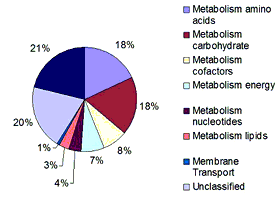 24 Feb 2005
24 Feb 2005
Prokaryote to eukaryote gene transfer is evident in the sequenced genome of an intesinal parasite, Entamoeba histolyca. Probably 96 of its genes were transferred from parasitic bacteria "relatively recently," according to the international research team who sequenced the eukaryote's genome. "It is clear that among the 96 genes, some result in significant enhancements to E. histolytica metabolism, thus contributing to its biology to a greater extent than indicated by the numbers alone." (The pie chart shows the predicted functional categories of most of the recently transferred genes.) This research adds to the mounting evidence for important lateral gene transfer, not merely among bacteria, but across all three domains of life.
 Brendan Loftus et al. (54 authors), "The genome of the protist parasite Entamoeba histolytica" [abstract], p 865-868 v 433, Nature, doi:10.1038/nature03291, 24 Feb 2005. Brendan Loftus et al. (54 authors), "The genome of the protist parasite Entamoeba histolytica" [abstract], p 865-868 v 433, Nature, doi:10.1038/nature03291, 24 Feb 2005.
 Genome of Deadly Amoeba Sequenced, by Mason Inman, ScienceNow, 24 Feb 2005. Genome of Deadly Amoeba Sequenced, by Mason Inman, ScienceNow, 24 Feb 2005.
 Viruses... is a related CA webpage about mechanisms of gene transfer. [Next-What'sNEW about HGT-Prev] Viruses... is a related CA webpage about mechanisms of gene transfer. [Next-What'sNEW about HGT-Prev]

 Hoover Hoover |
24 Feb 2005
Bacteria frozen for 30,000 years revived as soon as they thawed, according to Richard Hoover, of NASA's Marshall Space Flight Center in Alabama. Recovered in permafrost ice near Fox, Alaska, the previously unknown bacteria are believed to have frozen during the Pleistocene Age. "The instant the ice melted they started swimming," said Hoover. Could similar bacteria be frozen in martian subsurface ice today?
 NASA Astrobiologist Identifies New 'Extreme' Life Form, by Steve Roy, Marshall Space Flight Center, 23 Feb 2005. NASA Astrobiologist Identifies New 'Extreme' Life Form, by Steve Roy, Marshall Space Flight Center, 23 Feb 2005.
 Creatures frozen for 32,000 years still alive, by Robert Roy Britt, MSNBC, 24 Feb 2005. Creatures frozen for 32,000 years still alive, by Robert Roy Britt, MSNBC, 24 Feb 2005.
 Ice age bacteria brought back to life, by Kelly Young, NewScientist.com, 25 Feb 2005. Ice age bacteria brought back to life, by Kelly Young, NewScientist.com, 25 Feb 2005.
 Richard Macey and agencies, "Alaska find raises hopes of life on Mars" [free registration], The Sydney Morning Herald, 25 Feb 2005. Richard Macey and agencies, "Alaska find raises hopes of life on Mars" [free registration], The Sydney Morning Herald, 25 Feb 2005.
 Evidence for Indigenous Microfossils in a Carbonaceous Meteorite describes other research by Richard Hoover. Evidence for Indigenous Microfossils in a Carbonaceous Meteorite describes other research by Richard Hoover.
 Bacteria... is a related CA webpage. Bacteria... is a related CA webpage.
 Life on Mars! is a related CA webpage. Life on Mars! is a related CA webpage.
 Thanks, George Stratton and Larry Klaes. Thanks, George Stratton and Larry Klaes.
 21 Feb 2005
21 Feb 2005
Only 13% of adults in the US fully accept the theory of evolution, according to a CBS/New York Times poll taken 18-21 Nov 2004. We think this lack of acceptance might reveal discernment, not ignorance.

 Jim Holt, "Unintelligent Design" [text], The New York Times, 20 Feb 2005. Jim Holt, "Unintelligent Design" [text], The New York Times, 20 Feb 2005.
 Poll: Creationism Trumps Evolution, CBSNews.com, 22 Nov 2004. Poll: Creationism Trumps Evolution, CBSNews.com, 22 Nov 2004.
 Evolution vs Creationism is a related CA webpage. Evolution vs Creationism is a related CA webpage.
 21 Feb 2005 21 Feb 2005
Duplication makes a new primate gene, according to German molecular biologists. Besides duplication, they observed inversion, partial deletion, recombination and positive selection on the reconstructed path to the new gene family in humans. On a new webpage, we ask how this reconstruction fits with the mainstream darwin theory of evolution, and with our amended version, cosmic ancestry.
 Duplication Makes a New Primate Gene — the new CA webpage, 21 Feb 2005. Duplication Makes a New Primate Gene — the new CA webpage, 21 Feb 2005.
 Viruses and Other Gene Transfer Mechanisms is a related CA webpage. [Next-What'sNEW about HGT-Prev] Viruses and Other Gene Transfer Mechanisms is a related CA webpage. [Next-What'sNEW about HGT-Prev]
 Francesca D. Ciccarelli et al., "Complex genomic rearrangements lead to novel primate gene function" [abstract], Genome Research, doi:10.1101/gr.3266405, online 14 Feb 2005. Francesca D. Ciccarelli et al., "Complex genomic rearrangements lead to novel primate gene function" [abstract], Genome Research, doi:10.1101/gr.3266405, online 14 Feb 2005.
 Scientists Document Complex Genomic Events Leading To The Birth Of New Genes, ScienceDaily, 15 Feb 2005. Scientists Document Complex Genomic Events Leading To The Birth Of New Genes, ScienceDaily, 15 Feb 2005.
 Thanks, Jim Galasyn. Thanks, Jim Galasyn.
 16 Feb 2005 16 Feb 2005
Formaldehyde on Mars is another reason to suppose life is there, according to Vittorio Formisano of the Institute of Physics and Interplanetary Science in Rome. He thinks the formaldehyde comes from methane. If so, methane on Mars must be produced in greater quantity than previously thought.
 A whiff of life on the Red Planet, by Jenny Hogan, NewScientist, 16 Feb 2005. A whiff of life on the Red Planet, by Jenny Hogan, NewScientist, 16 Feb 2005.
 Life on Mars! is a related CA webpage. Life on Mars! is a related CA webpage.

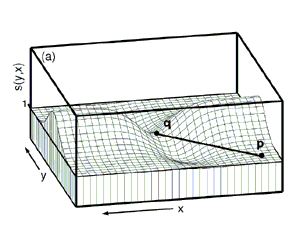 16 Feb 2005
16 Feb 2005
Fitness Landscapes — We are curious about this metaphor, first introduced by Sewall Wright in 1932. Since then, the image of a fitness landscape has often been used to suggest how evolution may produce complex features, as in Richard Dawkins's Climbing Mount Improbable (1996). We have long wondered: What does height on the landscape stand for? What does the vertical axis measure? We fear that ambiguity on this issue may lead to unjustified conclusions. Therefore we were very interested to read the scholarly new book, Fitness Landscapes and the Origin of Species, by evolutionary biologist and mathematician Sergey Gavrilets, published by Princeton University Press. It is the 41st book in the series, "Monographs in Population Biology." Its list of mathematical symbols occupies four pages.
Gavrilets acknowledges ambiguity about the traditional metaphor and answers our question simply: the vertical dimension stands for "fitness." He elaborates, "Fitness is traditionally interpreted as a characteristic of an individual. In most cases it is viability (i.e., the probability to survive to the age of reproduction)" (p 40). He goes on to say that the components of fitness may include "fitness selection, sexual selection, and prezygotic RI [reproductive isolation]" (p 48). Later he lists fitness components as "viability, fertility, or sexual attractiveness" (p 143). This list is reiterated in different order in the Index (p 462). Nowhere does he specify any unit of measure for fitness. Meanwhile, the horizontal plane represents "the set of all possible genotypes" (p 25), as customarily. This set has far more than two dimensions, so the plane is a necessary, standard simplification. For a minor quibble, Gavrilets defines "Hamming distance" as differences in sequences of genes (Eq 2.4 and accompanying text, p 26). But in biology it usually means differences in sequences of nucleotides. Nucleotides outnumber genes by three to seven orders of magnitude in eukaryotes, so the Hamming distance between different genomes is far larger by the standard definition than by Gavrilets'. This point would matter if Gavrilets were analyzing the evolution of new genetic programs, but he isn't.
 The focus of the book actually is "speciation," or the origin of reproductive isolation, among eukaryotes. While this phenomenon is interesting, it is only indirectly related to the creation of new genetic programs for more complex evolutionary features. Thus, the book does not begin to suggest how Dawkins' "Mount Improbable" could be climbed. The landscapes that Gavrilets analyzes are confined to very small genetic ranges that do not contain new programs for new features. Besides, a fitness landscape and an "organized complexity landscape" would not remotely resemble each other. Consider hardy fungi: among eukaryotes they are extremely high in fitness, but relatively lower in organized complexity. Ignoring the difference between fitness and organized complexity introduces the confusion that concerned us originally.
The focus of the book actually is "speciation," or the origin of reproductive isolation, among eukaryotes. While this phenomenon is interesting, it is only indirectly related to the creation of new genetic programs for more complex evolutionary features. Thus, the book does not begin to suggest how Dawkins' "Mount Improbable" could be climbed. The landscapes that Gavrilets analyzes are confined to very small genetic ranges that do not contain new programs for new features. Besides, a fitness landscape and an "organized complexity landscape" would not remotely resemble each other. Consider hardy fungi: among eukaryotes they are extremely high in fitness, but relatively lower in organized complexity. Ignoring the difference between fitness and organized complexity introduces the confusion that concerned us originally.
Nevertheless, even we are sometimes seduced by the image of landscapes. Thus we were intrigued by Gavrilets's occasional speculations on the characteristics of larger landscapes. At one point he cites research indicating, "Increasing complexity leads to severe constraints on the levels of optimization that can be attained by selection" (p 50). But as complexity is not his interest, he concludes, "No fitness valleys have to be crossed for substantial genetic divergence of populations and speciation" (p 114).
As our readers know, we suspect that any new genetic program must be first acquired in exon- or larger-sized pieces by events of gene transfer (a phenomenon almost never mentioned by Gavrilets.) If so, a full fitness landscape would be spikey or fractal, without smooth, gradually ascending paths leading to new genetic programs. But all of this is merely theoretical. If darwinian evolution can compose new genetic programs, there should be not only graphs of metaphors, but convincing, repeatable closed-system demonstrations in biology or computer models.
 Sergey Gavrilets, Fitness Landscapes and the Origin of Species, Princeton University Press, 2004. Sergey Gavrilets, Fitness Landscapes and the Origin of Species, Princeton University Press, 2004.
 Here Be Dragons is CA's review of a different book exemplifying the confusion about landscapes, 25 Mar 2003. Here Be Dragons is CA's review of a different book exemplifying the confusion about landscapes, 25 Mar 2003.
 Neo-Darwinism... is a related CA webpage with some links about Fitness Landscapes in the Genetics: What'sNEW section. Neo-Darwinism... is a related CA webpage with some links about Fitness Landscapes in the Genetics: What'sNEW section.
 Is Sustained Macroevolutionary Progress Possible? is one of several CA webpages calling for closed-system demonstrations. Is Sustained Macroevolutionary Progress Possible? is one of several CA webpages calling for closed-system demonstrations.
 18 May 2017: Martin Nowak says fitness landscapes are no help. 18 May 2017: Martin Nowak says fitness landscapes are no help.
 4 Feb 2005
4 Feb 2005
 Ernst Mayr died yesterday at 100 years of age, near Harvard University, where he spent half his life. An ornithologist, he was instrumental in shaping the "modern synthesis" of evolutionary theory. He was not afraid to ask challenging questions, like "Does microevolution explain macroevolution?" We feel fortunate to have known him, if only a little.
Ernst Mayr died yesterday at 100 years of age, near Harvard University, where he spent half his life. An ornithologist, he was instrumental in shaping the "modern synthesis" of evolutionary theory. He was not afraid to ask challenging questions, like "Does microevolution explain macroevolution?" We feel fortunate to have known him, if only a little.
 Ernst Mayr Dies, by Elizabeth Pennisi, Science Now, 4 Feb 2005. Ernst Mayr Dies, by Elizabeth Pennisi, Science Now, 4 Feb 2005.
 Ernst Mayr Dies, aged 100, by Michael Hopkin, News@Nature.com, 4 Feb 2005. Ernst Mayr Dies, aged 100, by Michael Hopkin, News@Nature.com, 4 Feb 2005.
 Jerry A. Coyne, "Ernst Mayr (1904-2005)" [summary], p 1212-1213 v 307, Science, doi:10.1126/science.1110718, 25 Feb 2005. Jerry A. Coyne, "Ernst Mayr (1904-2005)" [summary], p 1212-1213 v 307, Science, doi:10.1126/science.1110718, 25 Feb 2005.
 Ernst Mayr... is our report after meeting Mayr, 12 Jun 2000. Ernst Mayr... is our report after meeting Mayr, 12 Jun 2000.
 Neo-Darwinism... is a related CA webpage that references Mayr's position on micro- and macroevolution. Neo-Darwinism... is a related CA webpage that references Mayr's position on micro- and macroevolution.
 Thanks, George Stratton. Thanks, George Stratton.
 3 Feb 2005
3 Feb 2005
Complex early genes — Molecular biologists Scott W. Roy and Walter Gilbert of Harvard University have analyzed available data from seven fully sequenced eukaryotic genomes to investigate introns. They reach two surprising conclusions: eukaryotic introns seem to be very old, and genomes with nearly as many introns as modern organisms existed at the time of the plant-animal split. "This is a sharp repudiation of the common assumption that intron-riddled gene structures arose only recently."
 As our readers know, we believe that eukaryotes acquire new genetic programs by horizontal transfer, and that introns participate in the installation process. We are intrigued by this new study, because very old introns and complex early genomes are consistent with our belief and may help to clarify it.
Of course, historical reconstructions like this one depend on a number of assumptions. In particular, we wondered why Roy and Gilbert gave so little consideration to "parallel insertion," or intron "homing," when their cited evidence and references do not seem to justify this treatment. And we wish that everyone would avoid the word "origin" without positive evidence thereof. "Earliest known example" is usually all that's warranted. But we are pleased that these experts explicitly suggest "a reconsideration of the genomics of eukaryotic emergence."
 Scott W. Roy and Walter Gilbert, "Complex early genes" [abstract], Proc. Natl. Acad. Sci. USA, doi:10.1073/pnas.0408355101, online 1 Feb 2005. Scott W. Roy and Walter Gilbert, "Complex early genes" [abstract], Proc. Natl. Acad. Sci. USA, doi:10.1073/pnas.0408355101, online 1 Feb 2005.
 Viruses... is a related CA webpage about horizontal gene transfer. [Next-What'sNEW about HGT-Prev] Viruses... is a related CA webpage about horizontal gene transfer. [Next-What'sNEW about HGT-Prev]
 Introns... is a related CA webpage. Introns... is a related CA webpage.
 Testing Darwinism... is a related CA webpage that discusses historical reconstructions. Testing Darwinism... is a related CA webpage that discusses historical reconstructions.
 Metazoan Genes Older Than Metazoa? discusses evidence for genes older than darwinists expected. Metazoan Genes Older Than Metazoa? discusses evidence for genes older than darwinists expected.
 Dr. Scott Roy replies to our enquiry on two points, and notes errors in our original text (now corrected), 3 Feb 2005. Dr. Scott Roy replies to our enquiry on two points, and notes errors in our original text (now corrected), 3 Feb 2005.

 1 Feb 2005
1 Feb 2005
Moss grew in a spiral pattern in the darkness and weightlessnes of space. This observation comes from moss seeds that were grown aboard the Columbia Space Shutttle two years ago. Although Columbia was destroyed upon re-entering the atmosphere, recovery teams found 87 of the 100 original experimental cannisters scattered across a five-mile area around Bronson, Texas. Eleven of them were fairly intact. Fred Sack of Ohio State University, who led the study, believes that removing both light and gravity reveals a more primitive mode of growing. "Perhaps spirals are a vestigial growth pattern that became masked when moss evolved to respond to gravity," he says. "That's the only explanation that makes sense so far." The plants apparently already contained genetic instructions for growing in space.
 Mossy spirals reveal primitive patterns, by Mark Peplow, News@Nature.com, 31 Jan 2005. Mossy spirals reveal primitive patterns, by Mark Peplow, News@Nature.com, 31 Jan 2005.
 'Moss In Space' Project Shows How Some Plants Grow Without Gravity, by Holly Wagner, Ohio State Univesity, 26 Jan 2005. 'Moss In Space' Project Shows How Some Plants Grow Without Gravity, by Holly Wagner, Ohio State Univesity, 26 Jan 2005.
 Volker D. Kern et al., "Gravitropic moss cells default to spiral growth on the clinostat and in microgravity during spaceflight" [abstract], Planta, doi:10.1007/s00425-004-1467-3, online 20 Jan 2005. Volker D. Kern et al., "Gravitropic moss cells default to spiral growth on the clinostat and in microgravity during spaceflight" [abstract], Planta, doi:10.1007/s00425-004-1467-3, online 20 Jan 2005.

 23 Jan 2005
23 Jan 2005
Huygens landed on Titan, returning images and other data during and after its 14 January descent. The European Space Agency comments, "The surface is darker than originally expected, consisting of a mixture of water and hydrocarbon ice." The source of Titan's methane is one of the mysteries that this mission should help to resolve.
 Huygens lands on Titan, European Space Agency, 14 Jan 2005. Huygens lands on Titan, European Space Agency, 14 Jan 2005.
 Methane World: Interview with Toby Owen, Part II, Astrobiology Magazine, 19 Jan 2005. Methane World: Interview with Toby Owen, Part II, Astrobiology Magazine, 19 Jan 2005.
 Titan reveals methane rain and rocks of water, by Achim Schneider, News@nature.com, 21 Jan 2005. Titan reveals methane rain and rocks of water, by Achim Schneider, News@nature.com, 21 Jan 2005.
 Methane rivers and rain shape Titan's surface, NewScientist.com, 21 Jan 2005. Methane rivers and rain shape Titan's surface, NewScientist.com, 21 Jan 2005.
 Life on Europa ... has links to news about possible life elsewhere (besides Earth and Mars) in the solar system. Life on Europa ... has links to news about possible life elsewhere (besides Earth and Mars) in the solar system.
 20 Jan 2005
20 Jan 2005
 J. Craig Venter J. Craig Venter |
Life is ubiquitous throughout the universe. Life on our planet earth most likely is the result of a panspermic event.... Panspermia is how life is spread throughout the universe. These words come from J. Craig Venter's answer to the question, "What do you believe is true even though you cannot prove it?" Venter was the president of Celera Genomics, who sequenced the human genome using the whole genome shotgun technique. The completed sequence of the human genome was first published simultaneously by his team and an international consortium in February 2001. In 2003, Venter launched a global expedition to obtain and study microbes from environments ranging from oceans to urban centers.
 J. Craig Venter answers a question on Edge.org, January 2005. J. Craig Venter answers a question on Edge.org, January 2005.
 John Brockman, What We Believe but Cannot Prove: Today's Leading Thinkers on Science in the Age of Certainty, Harper Perennial, 2006. John Brockman, What We Believe but Cannot Prove: Today's Leading Thinkers on Science in the Age of Certainty, Harper Perennial, 2006. 
 Introduction... is a related CA webpage. Introduction... is a related CA webpage.
 Thomas Ray replies, 23 Jan 2005. Thomas Ray replies, 23 Jan 2005.
 David S. McKay replies, 21 Jan 2005. David S. McKay replies, 21 Jan 2005.
 The Human Genome... is CA's announcement of the work by Celera and the international consortium, 12 Feb 2001. The Human Genome... is CA's announcement of the work by Celera and the international consortium, 12 Feb 2001.
 Thanks, Susan Ballati and Melanie Wranaker. Thanks, Susan Ballati and Melanie Wranaker.

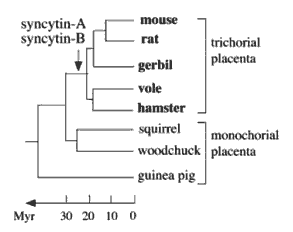 13 Jan 2005
13 Jan 2005
Genes from retroviruses — Geneticists recently identified two human endogenous retroviruses that entered the primate lineage 25-40 million years ago that are apparently important in the formation of the human placenta. Now some of the same geneticists report that two related retroviral genes have similar functions in mice, rats, gerbils, voles and hamsters. Their analysis indicates that these rodents acquired the genes after the rodent and primate lineages had already split. The geneticists conclude, "Our work and other reports... lead to the proposal that several independent retroviral infections may have contributed to the emergence of a common syncytial barrier in different species and played a pivotal convergent role in placenta morphogenesis and physiology."This example is another one of many now demonstrating that species may acquire important genetic programs by viral infection and other mechanisms of gene transfer. In our view, gene transfer could be the only way for new genetic programs to be acquired. If so, other genetic processes would still have to properly identify, assemble, position, activate and optimize the transferred genetic programs. We note that these latter processes are easily demonstrated in computer models. But computer models do not compose new programs. Without gene transfer, we have not seen evidence that genomes do either. (We think evidence matters.)
 Anne Dupressoir et al., "Syncytin-A and syncytin-B, two fusogenic placenta-specific murine envelope genes of retroviral origin conserved in Muridae" [abstract], 10.1073/pnas.0406509102, Proc. Natl. Acad. Sci. USA, online 11 Jan 2005. Anne Dupressoir et al., "Syncytin-A and syncytin-B, two fusogenic placenta-specific murine envelope genes of retroviral origin conserved in Muridae" [abstract], 10.1073/pnas.0406509102, Proc. Natl. Acad. Sci. USA, online 11 Jan 2005.
 What'sNEW 29 February 2000: Earlier news about the same genes in humans. What'sNEW 29 February 2000: Earlier news about the same genes in humans.
 Viruses... is a related CA webpage about gene transfer in all of life's domains by all mechanisms. [Next-What'sNEW about HGT-Prev] Viruses... is a related CA webpage about gene transfer in all of life's domains by all mechanisms. [Next-What'sNEW about HGT-Prev]
 2 Jan 2005
2 Jan 2005
 Lynn Margulis Lynn Margulis |
Gaia's History: The Living Earth from Space is the title of a lecture 10 January, at 7:30 p.m. in the Manuel Pacheco Integrated Learning Center at the University of Arizona, Tucson. The speaker is biologist Lynn Margulis of the University of Massachusetts. James Lovelock and she were the earliest proponents of the Gaia theory. The talk is the first in a new series at UA partly supported by a program called Astrobiology and the Sacred, funded by the John Templeton Foundation.
 Gaia's History: The Living Earth from Space, Astrobiology and the Sacred, University of Arizona. Gaia's History: The Living Earth from Space, Astrobiology and the Sacred, University of Arizona.
 Lynn Margulis answers a question on Edge.org, Jan 2005. Lynn Margulis answers a question on Edge.org, Jan 2005. 
 Gaia is a related CA webpage. Gaia is a related CA webpage.
 Thanks, Yahoo and Adrienne Gauthier! Thanks, Yahoo and Adrienne Gauthier!
 1 Jan 2005
1 Jan 2005
Gene exchange among archaebacteria from salt pools in Spain happens so frequently "that the genetics of the population is as diverse as if it reproduced sexually." Gene transfer is already recognized as the primary, if not the only mechanism by which eubacteria acquire new genetic programs. With examples from archaebacteria as well, this paradigm shift for prokaryotic evolution is now well-advanced. We think it should get more notice than it does.
 R. Thane Papke et al., "Frequent Recombination in a Saltern Population of Halorubrum" [abstract], p 1928-1929 v 306, Science, 10 Dec 2004. R. Thane Papke et al., "Frequent Recombination in a Saltern Population of Halorubrum" [abstract], p 1928-1929 v 306, Science, 10 Dec 2004.

 Bacteria... is a related CA webpage. Bacteria... is a related CA webpage.
 Viruses... is a related CA webpage about gene transfer in all of life's domains by all mechansms. [Next-What'sNEW about HGT-Prev] Viruses... is a related CA webpage about gene transfer in all of life's domains by all mechansms. [Next-What'sNEW about HGT-Prev]
|



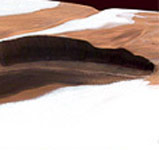

 16 Mar 2005
16 Mar 2005 15 Mar 2005
15 Mar 2005
 15 Mar 2005
15 Mar 2005
 24 Feb 2005
24 Feb 2005
 16 Feb 2005
16 Feb 2005 The focus of the book actually is "speciation," or the origin of reproductive isolation, among eukaryotes. While this phenomenon is interesting, it is only indirectly related to the creation of new genetic programs for more complex evolutionary features. Thus, the book does not begin to suggest how Dawkins' "Mount Improbable" could be climbed. The landscapes that Gavrilets analyzes are confined to very small genetic ranges that do not contain new programs for new features. Besides, a fitness landscape and an "organized complexity landscape" would not remotely resemble each other. Consider hardy fungi: among eukaryotes they are extremely high in fitness, but relatively lower in organized complexity. Ignoring the difference between fitness and organized complexity introduces the confusion that concerned us originally.
The focus of the book actually is "speciation," or the origin of reproductive isolation, among eukaryotes. While this phenomenon is interesting, it is only indirectly related to the creation of new genetic programs for more complex evolutionary features. Thus, the book does not begin to suggest how Dawkins' "Mount Improbable" could be climbed. The landscapes that Gavrilets analyzes are confined to very small genetic ranges that do not contain new programs for new features. Besides, a fitness landscape and an "organized complexity landscape" would not remotely resemble each other. Consider hardy fungi: among eukaryotes they are extremely high in fitness, but relatively lower in organized complexity. Ignoring the difference between fitness and organized complexity introduces the confusion that concerned us originally.
 Ernst Mayr died yesterday at 100 years of age, near Harvard University, where he spent half his life. An ornithologist, he was instrumental in shaping the "modern synthesis" of evolutionary theory. He was not afraid to ask challenging questions, like "Does microevolution explain macroevolution?" We feel fortunate to have known him, if only a little.
Ernst Mayr died yesterday at 100 years of age, near Harvard University, where he spent half his life. An ornithologist, he was instrumental in shaping the "modern synthesis" of evolutionary theory. He was not afraid to ask challenging questions, like "Does microevolution explain macroevolution?" We feel fortunate to have known him, if only a little. 1 Feb 2005
1 Feb 2005 23 Jan 2005
23 Jan 2005
 13 Jan 2005
13 Jan 2005